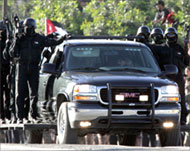US still biggest military spender
Global military spending shot to a record high in 2005, with expenditure on the rise in the US and the Middle East but on the decline in Europe.

The United States remained the biggest worldwide spender, with 48% of the $1.118 trillion pie and accounted for 80% of the $33 billion increase in global spending, the Stockholm International Peace Research Institute (SIPRI) said in its annual report.
The Middle East was the region with the highest relative spending increase, mostly because of a large increase in Saudi Arabia’s defence budget.
Total military spending numbers for the region would have been higher if Iraq and Qatar had not been excluded because of inconsistent data, the institute said.
Europe was the only region with a decrease in military spending, by 1.7%, especially because of western European spending cuts.
The biggest falls were recorded in Italy and Britain, the institute said.
Per capita
Worldwide military spending represented 2.5% of gross domestic product (GDP) in 2005, or $173 per capita.
 |
|
In 2005, global military spending |
In China, spending was $31.20 per capita, and in India, $18.50.
This compares with $1,604 of military spending for each American, and $1,430 for each Israeli, the institute said.
The 15 biggest spenders accounted for 84% of all expenditure.
They are, in declining order, the United States, Britain, France, Japan, China, Germany, Italy, Saudi Arabia, Russia, India, South Korea, Canada, Australia, Spain and Israel.
Sales figures
Arms sales by the 100 top worldwide companies rose 15% in 2004, the latest year for which figures are available.
Companies in the United States and Europe accounted for most of the amount.
The arms industry had become increasingly concentrated, the institute said, with the top five companies doubling their share of the top 100 to a combined 44% from 2003.
There were 17 major armed conflicts in 2005 in 16 locations, mostly in Asia, the lowest figure since the end of the Cold War.
For the second year running, no interstate conflicts were active.
With the end of the Cold War, religion has increasingly been viewed as an important element in many of the world’s conflicts, the institute said.